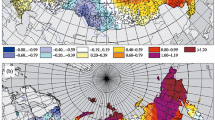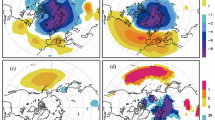Abstract
Considered is a relationship between long-term variations of the surface air temperature and of the field of geopotential at the level of 500 hPa in the middle of summer in the European part of Russia and the variations of large-scale atmospheric circulation described by the indices of North Atlantic and North Pacific centers of atmospheric action. The considerable inhomogeneity in the course of average temperature in the European part of Russia in July divides it into two periods, before and after the 1980s. Unlike stationary fluctuations of temperature before the 1980s, the 6–10-year fluctuations are typical of the period of 1981–2010 against a background of its considerable rise by 0.8°C per 10 years with the contribution of 20% to the total variance. During this period, about 80% of temperature variability are caused by the circulation variations, and 55% of them are associated with the North Pacific centers of atmospheric action, in particular, with the WP index in July, May, and April. Revealed regression dependences between circulation indices and the air temperature in the European part of Russia explain rather accurately the linear trend, the fluctuations with the period of 6–10 years, and the extremes in 1988, 2001–2003, and 2010. The analysis of the time series (1950–2012) of WP, PDO, and SOI indices demonstrates that changes in the atmospheric circulation took place in the extratropical zone of the Northern Hemisphere at the turn of the 1980s and this caused the formation of blocking situations and, hence, steady heat and drought in summer in the mid-latitude zone including the European part of Russia. These variations can be interpreted as a change in the regimes of strong (1950–1980) and weak (1981–2012) circulation. The heat in July 2010 was an extreme display of weak circulation, and this is indicated by the unprecedented low values of the WP index in July and May.
Similar content being viewed by others
References
P. N. Vargin, A. N. Luk’yanov, and A. V. Gan’shin, “Investigation of Dynamic Processes in the Period of Formation and Development of the Blocking Anticyclone over European Russia in Summer 2010,” Izv. Akad. Nauk, Fiz. Atmos. Okeana, No. 5, 48 (2012) [Izv., Atmos. Oceanic Phys., No. 5, 48 (2012)].
G. V. Gruza and E. Ya. Ran’kova, “Estimation of Probable Contribution of Global Warming to the Genesis of Abnormally Hot Summers in the European Part of Russia,” Izv. Akad. Nauk, Fiz. Atmos. Okeana, No. 6, 47 (2011) [Izv., Atmos. Oceanic Phys., No. 6, 47 (2011)].
Report on Climate Features on the Territory of the Russian Federation in 2011 (Roshydromet, Moscow, 2012) [in Russian].
I. I. Mokhov, “Specific Features of the 2010 Summer Heat Formation in the European Territory of Russia in the Context of General Climate Changes and Climate Anomalies,” Izv. Akad. Nauk, Fiz. Atmos. Okeana, No. 6, 47 (2011) [Izv., Atmos. Oceanic Phys., No. 6, 47 (2011)].
Assessment Report of Climate Changes and Their Consequences on the Territory of the Russian Federation, Vol. 1: Climate Changes (Roshydromet, Moscow, 2008) [in Russian].
V. V. Popova, “Current Variations of Surface Air Temperature in the North of Eurasia: Regional Trends and Importance of Atmospheric Circulation,” Izv. Akad. Nauk, Ser. Geograficheskaya, No. 6 (2009) [in Russian].
V. A. Rozhkov, Theory and Methods of Statistical Estimation of Probability Characteristics of Random Variables and Functions with Hydrometeorological Examples, Book 1 (Gidrometeoizdat, St. Petersburg, 2001) [in Russian].
N. P. Shakina and A. R. Ivanova, “The Blocking Anticyclones: The State of Studies and Forecasting,” Meteorol. Gidrol., No. 11 (2010) [Russ. Meteorol. Hydrol., No. 11, 35 (2010)].
R. Dole, M. Hoerling, J. Perlwitz, et al., “Was There a Basis for Anticipating the 2010 Russian Heat Wave,” Geophys. Res. Lett., 38 (2011).
R. H. Grumm and H. Richard, “The Central European and Russian Heat Event of July–August 2010,” Bull. Amer. Meteorol. Soc., 92 (2011).
A. Schneidereit, S. Schuber, P. Vargin, et al., “Large-scale Flow and the Long-lasting Blocking High over Russia: Summer 2010,” Mon. Wea. Rev., 140 (2012).
K. E. Trenberth and J. T. Fasullo, “Climate Extremes and Climate Change: The Russian Heat Wave and Other Climate Extremes of 2010,” J. Geophys. Res., 117 (2012).
K. E. Trenberth and J. W. Hurrell, “Decadal Atmosphere-Ocean Variations in the Pacific,” Climate Dynamics, 9 (1994).
A. J. Troup, “The Southern Oscillation,” Quart. J. Roy. Meteorol. Soc., 91 (1965).
Author information
Authors and Affiliations
Corresponding author
Additional information
Original Russian Text © V. V. Popova, 2014, published in Meteorologiya i Gidrologiya, 2014, No. 3, pp. 37–49.
About this article
Cite this article
Popova, V.V. Summertime warming in the European part of Russia and extreme heat in 2010 as manifestation of large-scale atmospheric circulation trends in the late 20th–early 21st centuries. Russ. Meteorol. Hydrol. 39, 159–167 (2014). https://doi.org/10.3103/S1068373914030042
Received:
Published:
Issue Date:
DOI: https://doi.org/10.3103/S1068373914030042




